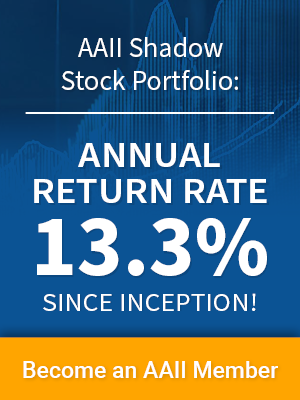Based on key financial metrics such as the price-to-sales ratio, shareholder yield and the price-earnings ratio, the following 3 stocks made the list for top value stocks in the Automobile Components industry. Those looking for value stocks to add to their portfolio may want to use this list as a starting point for further investment research.
Why Focus on Undervalued Automobile Components Stocks?
Value investors seek to buy stocks at a discount to their intrinsic value. Long-term returns show that such strategies are advantageous. Value stocks, as a group, tend to outperform growth stocks over extended periods of time. Typically, value investors perform financial analysis of numerous metrics, don’t follow the herd and are long-term investors.
AAII’s A+ Investor Value Grade is derived from a stock’s Value Score. The Value Score is the percentile rank of the average of the percentile ranks of the price-to-sales ratio, price-earnings ratio, enterprise-value-to-EBITDA (EV/EBITDA) ratio, shareholder yield, price-to-book-value ratio and price-to-free-cash-flow ratio. The score is variable, meaning it can consider all six ratios or, should any of the six ratios not be valid, the remaining ratios that are valid. To be assigned a Value Score, stocks must have a valid (non-null) ratio and corresponding ranking for at least two of the six valuation ratios.
What Goes Into AAII’s Value Grade?
Stock evaluation requires access to huge amounts of data as well as the knowledge and time to sift through it all, make sense of financial ratios, read income statements and analyze recent stock movement. AAII created A+ Investor, a robust data suite that condenses data research in an actionable and customizable way suitable for investors of all knowledge levels, to help investors with that task.
AAII’s proprietary stock grades come with A+ Investor. These offer intuitive A–F grades for more than just value. It is possible for a stock to appear cheap based on one valuation metric but appear expensive on another. It is also possible for one valuation ratio to be associated with outperforming stocks during certain periods of time but not others. Some stocks may even have null values for certain metrics like the price-earnings ratio or the price-to-book ratio but not others. An example of this would be a company with losses instead of profits or a negative book value because of heavy borrowing. Negative earnings or book value result in non-meaningful ratios that are left blank or null.
Click the button below to learn more about A+ Investor and subscribe today.

3 Undervalued Automobile Components Stocks
Of course, there are countless value stocks that are worth mentioning, but this is a concise list of the top 3 undervalued stocks in the Automobile Components industry for Thursday, October 23, 2025. Let’s take a closer look at their individual scores to see how they measure up against each other and the Automobile Components industry median.
| Company | Ticker | Price/Sales | Price/Earnings | EV/EBITDA | Shareholder Yield | Price/Book Value | Price/Free Cash Flow | Value Grade |
| Motorcar Parts of America, Inc. | MPAA | 0.41 | 199.5 | 5.9 | 1.6% | 1.20 | 4.4 | B |
| PHINIA Inc. | PHIN | 0.68 | 21.3 | 5.1 | 13.8% | 1.30 | 20.6 | A |
| Standard Motor Products, Inc. | SMP | 0.54 | 13.8 | 7.8 | 2.1% | 1.30 | 61.5 | B |
The Value Grade is assigned based on how each stock’s composite valuation compares to all other stocks.
The process for assigning grades starts with each variable for a given stock. The percentile rankings for all valid ratios that a stock has are calculated. So, for instance, a stock could have a price-to-book ranking in the 43rd percentile, a price-earnings ranking in the 67th percentile, a price-to-sales ranking in the 23rd percentile, etc. Then, those rankings are averaged for each stock. (A minimum of two valid variables are required, though all six will be used if available.)
Once the average of the individual variables is calculated, that average is ranked against all stocks. Put another way, each stock’s composite valuation is compared to all other stocks. These ranks are then sorted into quintiles from the cheapest 20% (a grade of A) to the most expensive 20% (a grade of F).
As always, we recommend that you conduct proper due diligence and research before investing in any security. We also suggest that investors utilize numerous grades, not just value, when it comes to deciding whether a company is a good fit for their allocation needs.
Motorcar Parts of America, Inc.’s Value Grade
Value Grade:
| Metric | Score | MPAA | Industry Median |
| Price/Sales | 15 | 0.41 | 0.77 |
| Price/Earnings | 97 | 199.5 | 18.6 |
| EV/EBITDA | 13 | 5.9 | 9.6 |
| Shareholder Yield | 34 | 1.6% | 0.0% |
| Price/Book Value | 32 | 1.20 | 1.50 |
| Price/Free Cash Flow | 8 | 4.4 | 15.6 |
Motorcar Parts of America, Inc. manufactures, remanufactures, and distributes heavy-duty truck, industrial, marine, and agricultural application replacement parts in the United States. It operates through three segments: Hard Parts, Test Solutions and Diagnostic Equipment, and Heavy Duty. The company offers light duty rotating electrical products, including alternators and starters; wheel hub assemblies and bearings; brake-related products comprising brake calipers, brake boosters, brake rotors, brake pads, and brake master cylinders; and turbochargers. It also provides test solutions and diagnostic equipment that include applications for combustion engine vehicles, such as bench-top testers for alternators and starters; equipment for the pre- and post-production of electric vehicles; and software emulation of power systems applications for the electrification of various forms of transportation. In addition, the company offers heavy duty parts, including non-discretionary automotive aftermarket replacement hard parts for heavy-duty truck, industrial, marine, and agricultural applications. It sells its products to automotive retail chain stores and warehouse distributors in North America, as well as various automobile manufacturers for their aftermarket programs and warranty replacement programs. The company provides its products under the Private Label, Quality-Built, Pure Energy, D&V; Electronics, Dixie Electric, and DelStar brands. Motorcar Parts of America, Inc. was incorporated in 1968 and is headquartered in Torrance, California.
Stocks with a Value Score from 81 to 100 are considered deep value, those with a score between 61 and 80 are value and so on.
Motorcar Parts of America, Inc. has a Value Score of 77, which is considered to be undervalued.
When you look at Motorcar Parts of America, Inc.’s price-to-sales ratio at 0.41 compared to the industry median at 0.77, this company has a lower price relative to revenue compared to its peers. This could make Motorcar Parts of America, Inc.’s stock more attractive for value investors.
Motorcar Parts of America, Inc.’s price-earnings ratio is 199.50 compared to the industry median at 18.60. This means it has a higher share price relative to earnings compared to its peers. This could make Motorcar Parts of America, Inc. less attractive for value investors.
Now, let’s assess Motorcar Parts of America, Inc.’s EV/EBITDA ratio, also known as enterprise multiple. At 5.9, when compared to the industry median of 9.6, the company may be considered undervalued in relation to its peers. Value investors could use the enterprise multiple to identify stocks that are considered overvalued or undervalued relative to their industry.
Shareholder yield is the sum of a stock’s dividend yield (paid over previous 12 months minus special dividends) and the percentage of net share buybacks over the previous 12 months. Motorcar Parts of America, Inc.’s shareholder yield is higher than its industry median ratio of 0.00%. Value investors may look for an attractive shareholder yield because it can be a powerful tool for identifying if the company has a good management team.
As one of the most common value metrics, the price-to-book ratio evaluates a company’s current market price relative to its book value. Motorcar Parts of America, Inc.’s price-to-book ratio is lower than its industry median ratio of 1.50. This could make Motorcar Parts of America, Inc. more attractive to investors looking for a new addition to their portfolio.
Lastly, let’s take a look at Motorcar Parts of America, Inc.’s price-to-free-cash-flow ratio (P/FCF), which can indicate a company’s market value relative to its operating cash flow. Motorcar Parts of America, Inc.’s price-to-free-cash-flow ratio is lower than its industry median ratio of 15.60. This could make Motorcar Parts of America, Inc. more attractive because the lower P/FCF ratio indicates that Motorcar Parts of America, Inc. is undervalued. The P/FCF ratio metric can also be viewed over a long-term time frame to see if the company's cash flow to share price value is generally improving or worsening.
PHINIA Inc.’s Value Grade
Value Grade:
| Metric | Score | PHIN | Industry Median |
| Price/Sales | 24 | 0.68 | 0.77 |
| Price/Earnings | 53 | 21.3 | 18.6 |
| EV/EBITDA | 10 | 5.1 | 9.6 |
| Shareholder Yield | 2 | 13.8% | 0.0% |
| Price/Book Value | 35 | 1.30 | 1.50 |
| Price/Free Cash Flow | 51 | 20.6 | 15.6 |
PHINIA Inc. engages in the development, design, and manufacture of integrated components and systems. The company operates through Fuel Systems and Aftermarket segments. The Fuel Systems segment provides advanced fuel injection systems, including pumps, injectors, fuel rail assemblies, and engine control modules; fuel delivery modules; canisters; sensors; and electronic control modules. The segment also offers complete systems comprising software and calibration services that reduce emissions and enhance fuel economy for traditional and hybrid applications. The Aftermarket segment is involved in the sale of starters, alternators, and remanufactured products, as well as maintenance, test equipment, and vehicle diagnostics solutions to original equipment manufacturers and original equipment service customers. Its products are used for commercial vehicles and industrial applications, such as medium-duty and heavy-duty trucks, buses and other off-highway construction, marine, agricultural and industrial applications; light commercial vehicles, including vans and trucks; and light passenger vehicles, including passenger cars, mini-vans, cross-overs and sport-utility vehicles. PHINIA Inc. was incorporated in 2023 and is based in Auburn Hills, Michigan.
Stocks with a Value Score from 81 to 100 are considered deep value, those with a score between 61 and 80 are value and so on.
PHINIA Inc. has a Value Score of 84, which is considered to be undervalued.
PHINIA Inc.’s price-earnings ratio is 21.3 compared to the industry median at 18.6. This means that it has a higher price relative to its earnings compared to its peers. This makes PHINIA Inc. less attractive for value investors.
PHINIA Inc.’s price-to-book ratio is higher than its peers. This could make PHINIA Inc. less attractive for value investors when compared to the industry median at 1.50.
You can read more about PHINIA Inc.’s key financial metrics like shareholder yield, price-to-free-cash-flow and EV/EBITDA ratio, or learn more about its Momentum and Growth Grades, by subscribing to A+ Investor.
Standard Motor Products, Inc.’s Value Grade
Value Grade:
| Metric | Score | SMP | Industry Median |
| Price/Sales | 20 | 0.54 | 0.77 |
| Price/Earnings | 32 | 13.8 | 18.6 |
| EV/EBITDA | 23 | 7.8 | 9.6 |
| Shareholder Yield | 31 | 2.1% | 0.0% |
| Price/Book Value | 35 | 1.30 | 1.50 |
| Price/Free Cash Flow | 85 | 61.5 | 15.6 |
Standard Motor Products, Inc. manufactures and distributes replacement automotive parts in the United States and internationally. The company operates through four segments: Vehicle Control, Temperature Control, Nissens Automotive, and Engineered Solutions. It provides ignition, emissions, and fuel delivery systems, such as air injection and induction components, air management valves, regulators and solenoids, exhaust gas recirculation components, fuel injectors and components, fuel valves, ignition coils, connectors and sockets, modules, pumps, relays and fuses, starting and charging system parts, and vapor and purge components. The company also offers electrical switches and actuators; anti-lock brake and vehicle speed sensors, fluid level sensors, and pressure sensors comprising tire pressure monitoring, temperature sensors, advanced driver assistance systems sensors, battery cables, pigtails, and sockets; electrical wire, terminals, connectors, and tools for servicing a vehicle’s electrical system; and spark plug, coil on plug boots, and ignition system accessories. In addition, it offers compressors, air conditioning repair kits, connecting lines, heat exchangers, and expansion devices; other thermal components; electric water pumps, condensers, electronics, turbochargers and intercoolers, and related components, as well as radiators and oil coolers, tanks, and fan clutches; and blowers, evaporators, expansion valves, and heaters. Further, it provides thermal management products, sensors, switches, power distribution, electrification and electronics, injections, and clamping devices for commercial and light vehicles, construction, agriculture, power sports, marine, hydraulics, and lawn and garden sectors. It serves retailers, warehouse distributors, original equipment manufacturers and their suppliers, system integrators, and original equipment service part manufacturers. The company was founded in 1919 and is headquartered in Long Island City, New York.
Stocks with a Value Score from 81 to 100 are considered deep value, those with a score between 61 and 80 are value and so on.
Standard Motor Products, Inc. has a Value Score of 69, which is considered to be undervalued.
Standard Motor Products, Inc.’s price-earnings ratio is 13.8 compared to the industry median at 18.6. This means that it has a lower price relative to its earnings compared to its peers. This makes Standard Motor Products, Inc. more attractive for value investors.
Standard Motor Products, Inc.’s price-to-book ratio is higher than its peers. This could make Standard Motor Products, Inc. less attractive for value investors when compared to the industry median at 1.50.
You can read more about Standard Motor Products, Inc.’s key financial metrics like shareholder yield, price-to-free-cash-flow and EV/EBITDA ratio, or learn more about its Momentum and Growth Grades, by subscribing to A+ Investor.

Other Automobile Components Stock Grades
Value is just one of the five Stock Grades included in our A+ Investor service. AAII members can see the top-graded stocks—those with grades of A or B for value, growth, momentum, earnings estimate revisions and quality—on the A+ Stock Grades Screener.
Also, if you want full access to all of AAII’s premium services, you can subscribe to one convenient bundled plan called AAII Platinum where you can try out A+ Investor, AAII Dividend Investing, the Stock Superstars Report, Growth Investing and VMQ Stocks. With the other premium services, you can dive deep into additional metrics, portfolios, commentary and information about Automobile Components stocks as well as other industrys.
Choosing Which of the 3 Best Automobile Components Stocks Is Right for You
Choosing which value stocks to invest in will ultimately depend on your individual goals and allocation; however, comparing similar value stocks in the same industry can help you analyze which might be better investments for you in the long run. So, let’s take a look at the Value Grade for all of our stocks.
- Motorcar Parts of America, Inc. stock has a Value Grade of B.
- PHINIA Inc. stock has a Value Grade of A.
- Standard Motor Products, Inc. stock has a Value Grade of B.
Now that you have a bit more background about each of the 3 undervalued stocks in the Automobile Components industry as well as their overall grades, it’s time for you to conduct additional research to see if these could fit your portfolio needs based on your goals and risk tolerance. AAII can help you figure out both and identify which investments align with what works best for you.
We do so through a program of education that teaches you to invest for yourself and become an effective manager of your own wealth—no more relying on others for your financial independence. You can rely on AAII for timeless articles on financial planning and stock-picking, unbiased research and actionable analysis that makes you a better investor.
A+ Investor adds to that qualitative teaching by giving you a powerful data suite that helps you whittle down investment decisions to find stocks, exchange-traded funds (ETFs) or mutual funds that meet your needs.

Additional Resources About Automobile Components Stocks
Want to learn more about Automobile Components stocks to see if they could be the right investment for you? Check out some additional resources and articles to help you on your financial journey.
- 3 Undervalued Automobile Components Stocks for Thursday, October 23
- 3 Undervalued Automobile Components Stocks for Wednesday, October 22
- Why ECARX Holdings Inc.’s (ECX) Stock Is Down 6.33%
- Why Hesai Group’s (HSAI) Stock Is Down 5.06%
AAII Disclaimer
We make no representations or warranties that any investor will, or is likely to, achieve profits similar to those shown, because past, hypothetical or simulated performance is not necessarily indicative of future results. Before making an investment decision, you should consider your circumstances and whether the information on our content is applicable to your situation. This information was prepared in good faith and we accept no liability for any errors or omissions. The full disclaimer can be read here.
 Included With AAII Platinum
Included With AAII Platinum
at only 23.3%
Since Inception. Data as of 12/31/2024.

769.3% Stock Superstars Portfolio Total Return Since Inception

U.S. Index ETF (IYY)
SSR Group 3 O'Shaughnessy portfolio has a 411.2% gain since inception performance compared to IYY at only 119.1%% Performance as of 11/29/24.
FREE REPORT

BECOME A MEMBER FOR ONLY $2
Get access to powerful investment discovery tools and a wealth of investment education to help you achieve your financial goals.




